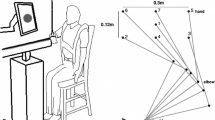Abstract.
A significant problem in motor control is how information about movement error is used to modify control signals to achieve desired performance. A potential source of movement error and one that is readily controllable experimentally relates to limb dynamics and associated movement-dependent loads. In this paper, we have used a position control model to examine changes to control signals for arm movements in the context of movement-dependent loads. In the model, based on the equilibrium-point hypothesis, equilibrium shifts are adjusted directly in proportion to the positional error between desired and actual movements. The model is used to simulate multi-joint movements in the presence of both "internal" loads due to joint interaction torques, and externally applied loads resulting from velocity-dependent force fields. In both cases it is shown that the model can achieve close correspondence to empirical data using a simple linear adaptation procedure. An important feature of the model is that it achieves compensation for loads during movement without the need for either coordinate transformations between positional error and associated corrective forces, or inverse dynamics calculations.
Similar content being viewed by others
Author information
Authors and Affiliations
Additional information
Electronic Publication
Rights and permissions
About this article
Cite this article
Gribble, P., Ostry, D. Compensation for loads during arm movements using equilibrium-point control. Exp Brain Res 135, 474–482 (2000). https://doi.org/10.1007/s002210000547
Received:
Accepted:
Issue Date:
DOI: https://doi.org/10.1007/s002210000547




